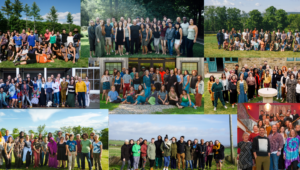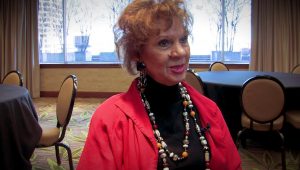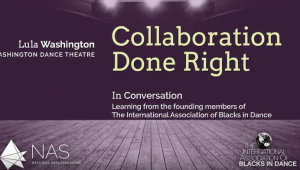This week continues our conversation on creative placemaking where we asked our Creative Community Fellows to talk about creative placemaking and what their role is as community-engaged artists. We discovered that for many of our Fellows, the work they do is about addressing the disconnect that exists not only within the communities in which they are currently working but across sectors and social boundaries. We found that many Fellows see their work as a means to bridge these divides.
In their conversation, Rachel Reynolds Luster and Laurelin Kruse discuss how this ultimately unites people:
“RACHEL: Cultural conversations are a wonderful way to bring a diversity of people together and bridge conversations between them that can lead to a strengthened community.
LAURELIN: For me, music has always been a way to get people together, whether that was through my experience throwing shows at the local coffee shop as a teenager in my small town (where, especially as a teenager, it seemed nothing ever happened) or putting on house concerts in the basement of my house in college. Recently, I organized a series of house concerts in rural towns and found it to be an amazing coming together of rowdy little kids, bored teens, and older generations who had been in the area their entire lives. It was also fascinating to have these people who had never met each other come together in the intimate space of someone’s living room.”
In their conversation, they agree it’s about creating the space for people to come together:
“RACHEL: I think you’re exactly right! You have to immerse yourself in a place enough to know what that “it” thing will be. For us, it’s been small-scale food production and consumption.
I think creating a welcoming space is critical. Every time we have an event, all kinds of people come. People connect too just in the daily operations of co-op. We’ve added a community kitchen, a cultural library of music, books, and art, and, when people are hanging out in there, they’re talking about things like “where’s the best place to get hay around here?” or “where can I find raw milk?” Soon, they find commonalities and that allows for a space where you can introduce more critical community issues. They might have vastly different religious or political beliefs, but creating an environment where they know it’s safe to contribute is pretty powerful stuff.”
Read Rachel and Laurelin’s entire conversation.
Scott Burkholder shares a similar belief. One of the two reasons that he is so invested in this type of work is that:
“Artists and society do not always know how to engage with each other…As a promoter of art, I am teaching the value of art and facilitating the various relationships that can exist between an artist and society.”
Read Scott’s entire conversation with Ali Fadlallah.
During their conversation, Sifiso Maposa and Nicolle Bennett note similar gaps between arts and culture and other sectors. Sifiso notes that people are talking about creative placemaking so much right now because:
“People are now realizing the creative potential that already exists in different communities and the importance of leveraging this potential. By getting everyone who is involved in arts and culture in their communities, out of the silos they exist in, communities can mobilize for social change. There is a sudden realization that change, participation, support can and should come from within communities.”
Nicolle discusses the need to address the disconnect that exists with all those who are involved in this community-centered work:
“In the course of this work, in speaking with community partners and with our teaching artists, there seem to exist many disconnects – between community members, between organizations, between funders and those they are looking to serve, and for artists looking for outlets to contribute, to have a say, to do more in the community, and/or to mentor but are not sure how (and who also have to make a living).”
Read Nicolle and Sifiso’s entire conversation.
Many Fellows are also focused on addressing pressing social and economic issues within their communities and bringing issues such as racial inequality and homelessness to light.
Justina Crawford-Williams and Christina Oi Ying Nip talk about the ways in which their work is focused on crossing these boundaries and divides:
“Together, Christina and I are determined to collaborate with our communities beyond differences, social labels, stereotypes, race, ethnicity, gender, age, and socio-economic statuses to help our communities thrive, connect, and be healthier as a result of creative and cultural programming.”
Read Justina and Christina’s entire conversation.
Monica Montgomery and Kristina Newman-Scott similarly see their roles as cultural entrepreneurs to effect change in these areas:
“As a cultural arbiter you transform into an activist by default, from grappling with bedrock issues of poverty, homelessness and education, then spinning society’s concern around that. All the things that are extremely important, can be viewed through an artistic lens, using creativity as a catalyst to address pressing issues and inequities and start citywide dialogues around cause, effect and proposed solutions.”
Throughout their conversation, both Monica and Kristina discuss being a part of a minority community and recognize that while in many ways arts and culture is used to bridge divides, these same divides also exist within the field:
“MONICA: I’m the kind of person that, when I go to a place and I experience I guess a lack, or I see a void I don’t get turned off by that, I don’t about face, I’m like you know what, I’m going to create something to fill that need. I’m sure if I feel this way others do too. I just wanted to see, and I still want to see people that look like myself working in the field. There is so much of the culture that is celebrated and comes from people of color and I feel that people of color should be running the show not just at the front desk, they should be heads and executive directors and chairs and I want to see more of that and so the only way that I can I guess is to start a conversation. Get other folks that are in the field talking about it and say hey, this is an issue, let’s see what we can do to solve it, or at least discuss it.
KRISTINA: Hartford is over 40% Hispanic. It’s you know, 30 odd percent African-American and the rest is Caucasian. Hartford is wonderful, unique and special, we have over 350 arts and cultural organizations within 18 square miles. I am the only person of color at almost every meeting within the arts and cultural sector here. And as I look around at the executive directors, of all of the arts and cultural spaces especially within the downtown, there are no people of color in senior leadership positions in a community that is predominantly of color, but who makes this community special because of the rich culture that they bring here. I mean we have over 70 languages. So I, you know, being fairly young. Being of color. Being in a leadership position. I’m like how are we working to show young people growing up in our community, that they can actually have a leadership position or they don’t just have to be answering phones at a museum.”
Read Monica and Kristina’s entire conversation.
For Fellow Ali Fadallah, one of the primary driving forces for the work he is doing is:
“Witnessing and working against inequality in education worldwide, but especially in the under served areas of America.”
Read Ali’s entire conversation with Scott Burkholder.
Similarly, the motivating factor behind for Rachel Hamilton’s work is:
“The lack of diversity in schools that are in neighborhoods where the population is so intensely diverse.”
In her conversation with Katy Moonan, they agree and Katy correspondingly notes that the work she is doing is focused on addressing the segregation in her community of Holyoke:
“I was also thinking along those same lines, that beyond the people who are directly participating in the project it’s also an opportunity to challenge a larger set of issues such as for example residential segregation…Holyoke is extremely segregated in terms of where people live and go to school and interact and it’s good to try as much as we can to draw together with those things that do have universal appeal like food, music and I think If its messaged in an inclusive way, art and culture have that same strong universal appeal…so it can help push back against invisible fences that divide some Holyokers from others and help people feel they are a recognized part of the larger community and part of a bigger world beyond their block.”
Read Rachel and Katy’s entire conversation.
It is evident that these artists and cultural entrepreneurs see their work as the catalyst for creating social change within their communities. They see the power that the field of arts and culture has to bridge divides, but also recognize that this sector can exist within its own silo and faces similar issues related to diversity and inclusion. How do you see the role of arts and culture in bridging the divides that exist within communities? How can the field of arts and culture increase diversity, equality and the cultural understanding between the members of a community? How do we address the gaps that exist within our own field?


